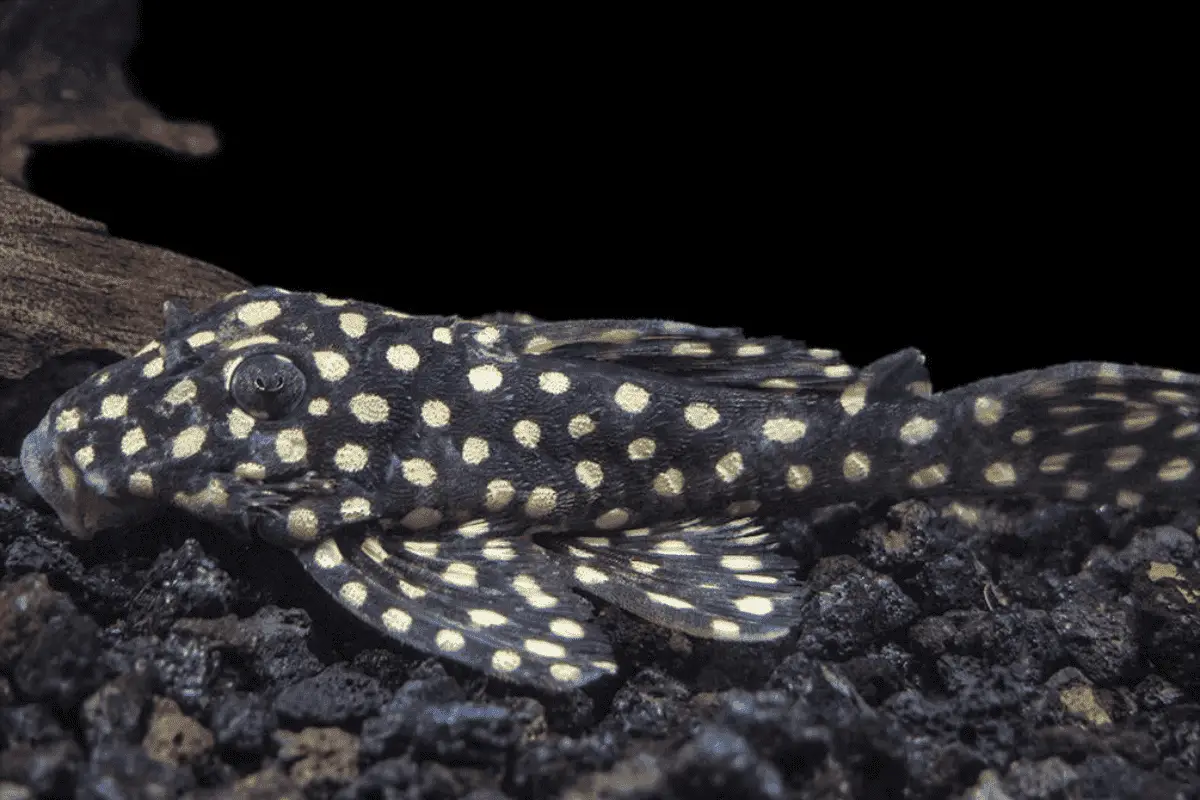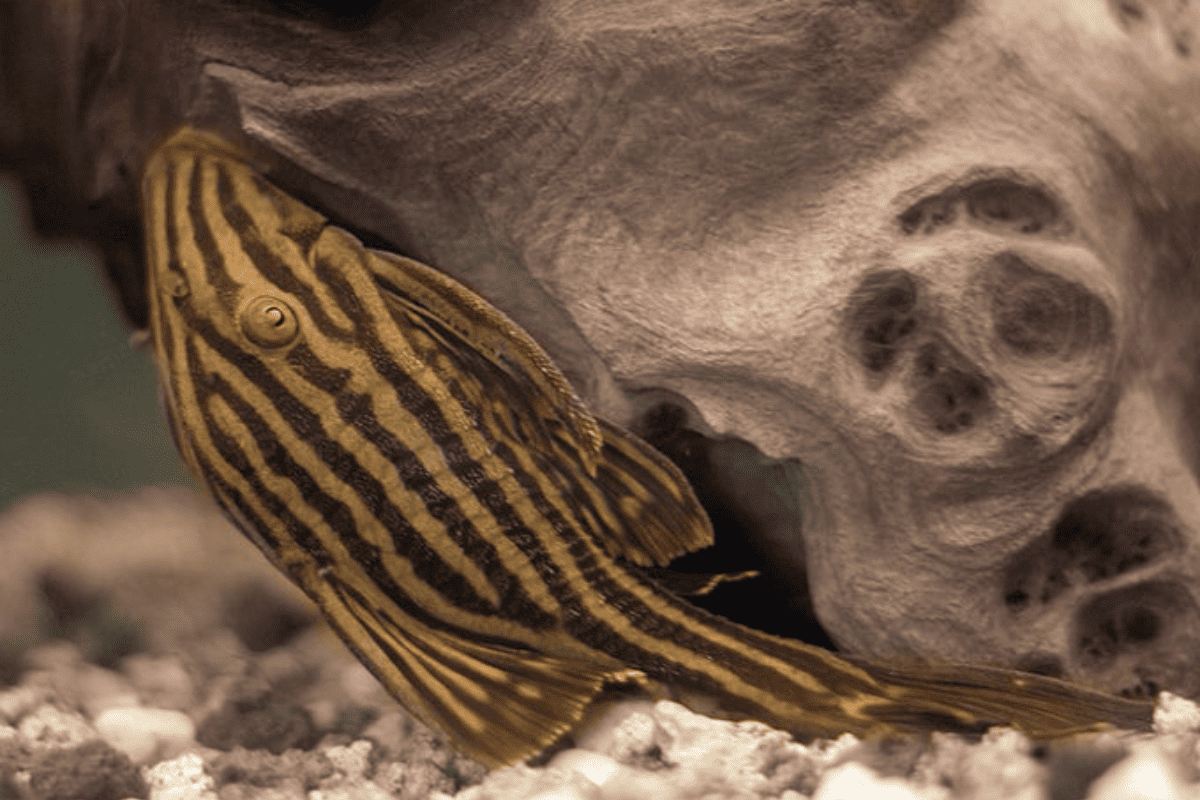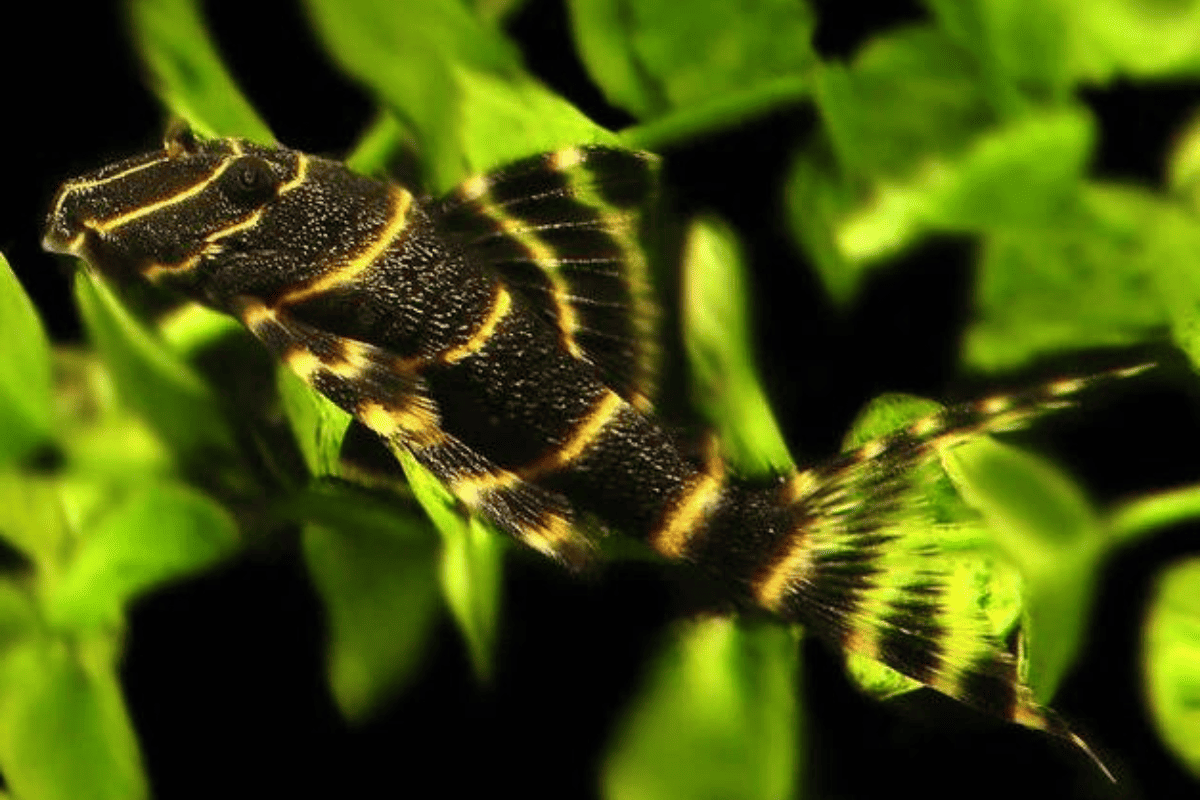Many fish keepers are aware that Plecos act as scavengers. But does this mean they consume whatever they come across in the aquarium?
What about fish waste? Will Plecos consume it? Can you count on them to remove fish waste from the tank? Are certain aquarium species more prone to this behavior?
In this article, I will answer all these questions and more, so you leave with all the information you need. Let’s get started.

Do Plecos Eat Fish Poop?
No, Plecos do not predominantly consume fish poop, even though their bottom-feeding habits might suggest so.
While they occasionally ingest small amounts during their scavenging routines, it isn’t their primary dietary source.
- Natural Diet: Plecos predominantly feed on algae, detritus, and a few aquatic organisms. Fish waste is not a deliberate part of their diet.
- Bottom Feeding Behavior: As Plecos frequently comb the tank floor for edible bits, they may consume trace amounts of fish poop, but it isn’t a mainstay.
- Common Misconception: Observing Plecos near waste often leads aquarists to believe they consume it. They’re typically after other food sources nearby.
- Dietary Needs: Plecos thrive on a varied diet which includes veggies and specific sinking pellets. Relying solely on waste would be nutritionally lacking.
- Species Variance: Different Pleco species have varied diets, but none have evolved specifically to feed on fish waste.
Also Read: What Do Plecos Eat?
What Do Plecos Typically Eat?
Plecos have a varied diet in home aquariums. Here are the main things they eat:
1. Algae

A primary food source for many Plecos is algae that grow on surfaces within the aquarium.
Naturally occurring in tanks, algae provide essential nutrients and are often scraped off by Plecos.
- Natural Behavior: In the wild, many Plecos, such as the common Pleco (Hypostomus plecostomus), graze on algae covering rocks and submerged surfaces.
- Tank Health: Algae consumption by Plecos can be beneficial, helping to keep tank walls and decorations free from excessive algal growth.
- Variety in Diet: Different species prefer various types of algae, with some like the Rubber Lip Pleco (Chaetostoma) having a penchant for softer green algae.
2. Sinking Algae Wafers

Formulated to mimic the natural food of Plecos, these wafers are a staple in aquarium care for these species. They’re dense, nutrient-rich, and designed to sink to the bottom.
- Balanced Diet: Wafers often contain a mix of vegetable matter and proteins, catering to the diverse dietary needs of Plecos.
- Popular Among Species: Many Pleco species, including the Bristlenose Pleco (Ancistrus), eagerly consume these wafers.
- Frequency: For optimal health, aquarists commonly feed Plecos these wafers 2-3 times weekly, depending on the tank’s natural food availability.
My recommendation: Invert Aquatics Mini Algae Discs (link to Amazon).
3. Vegetables

Fresh vegetables like zucchini, cucumber, and lettuce can be an excellent supplement for Plecos. They offer a break from their regular diet and supply vital nutrients.
- Feeding Methods: Aquarists can blanch veggies to soften them, making it easier for Plecos, such as the Clown Pleco (Panaqolus maccus), to feed.
- Nutrient Boost: Vegetables offer essential vitamins and minerals not always present in other foods.
- Variety: Offering a range of veggies ensures Plecos receive diverse nutrients, appealing especially to herbivorous species.
4. Detritus
Detritus, the decaying organic matter found at the bottom of tanks, is another source of food for some Plecos. Though not their primary diet, it’s often consumed during scavenging.
- Clean-up Crew: Plecos, like the Whiptail Pleco (Rineloricaria), play a role in consuming detritus, assisting in keeping substrate cleaner.
- Organic Matter: Detritus consists of dead plant matter, uneaten food, and other organic waste, offering additional nutrients.
- Natural Behavior: In natural habitats, Plecos will sift through substrate, ingesting detritus alongside other food particles.
5. Driftwood

Some Pleco species not only use driftwood as a hiding place but also feed on it, deriving necessary nutrients from the wood’s fiber.
- Special Diet: Species like the Royal Pleco (Panaque nigrolineatus) require wood in their diet, extracting cellulose from it.
- Digestive Adaptation: These Plecos possess specialized gut bacteria to break down wood fibers, enabling nutrient absorption.
- Natural Environment Replication: Providing driftwood replicates the natural riverine environments of certain Plecos, promoting healthy behaviors and digestion.
My recommendation: Dr. Moss Aquarium Bogwood (link to Amazon).
Do Bottom Feeders Consume Fish Waste?
No, most bottom feeders, distinct from Plecos, don’t actively consume fish waste. They primarily seek other organic tank materials.
Here are some common examples:
- Corydoras Catfish: These armored catfish sift substrate for food, preferring worms and small insects over waste.
- Loaches: Species like Clown Loach focus on protein-rich diets, including snails and invertebrates, not fish waste.
- Shrimp: Freshwater species, e.g., Amano shrimp, focus on plant matter, detritus, and biofilm rather than waste.
- Snails: Types like Nerite snails consume algae and decaying plants; fish waste isn’t a primary food source for them.
Which Fish Species Have a Tendency to Consume Fish Waste?
Few fish species deliberately consume fish waste, and even for those that do, it’s not their primary food source.
However, there are some species that might nibble on fish waste occasionally while scavenging.
- Corydoras Catfish: While these bottom feeders primarily consume worms and small invertebrates, they might inadvertently ingest tiny amounts of fish waste when sifting through substrate.
- Some Catfish Varieties: Certain species, especially those that root around in the substrate, might consume fish waste alongside other detritus, but not as a primary diet.
- Detritivorous Fish: Species such as the Silver Dollar occasionally snack on waste but mainly focus on plant material and detritus.
- Certain Cichlids: Some cichlids, especially substrate-sifting types, might pick up fish waste while searching for small invertebrates or other food.
- Miscellaneous Scavengers: Other bottom-dwelling scavengers, while preferring algae, worms, or invertebrates, might consume minuscule amounts of waste amid their usual diet.

Do Snails Feed on Fish Waste?
No, snails don’t primarily consume fish waste in aquariums. While scavenging, they may ingest small amounts, but it’s not their primary dietary source.
- Algae Eaters: Many snails, like the Nerite, actively feed on algae, which makes up the bulk of their diet in tanks.
- Decomposers: Snails often consume decomposed plant matter and uneaten fish food, helping to keep the tank clean.
- Comparison with Plecos: Plecos, like snails, primarily focus on algae and detritus, inadvertently ingesting tiny amounts of fish waste during their scavenging activities.
Do Shrimp Eat Fish Waste?
No, shrimp don’t typically consume fish waste. Their diet mainly comprises biofilm, algae, and detritus, with fish waste not being a sought-after food item.
- Biofilm Grazers: Shrimp, especially Amano shrimp, graze on biofilm which forms on various surfaces in the aquarium.
- Scavenger Role: While they do scavenge for food, shrimp are more interested in consuming dead plant matter and leftover food particles.
- Contrasting Plecos: Plecos, although similar in their scavenging nature, have a more varied diet that might, on rare occasions, include minute amounts of fish waste.
Why Might Your Fish Be Consuming Poop?
Fish typically don’t seek out waste as food. If they’re consuming it, there might be underlying reasons related to their environment or health.
- Insufficient Diet: Fish, when not adequately fed, might turn to available materials, even waste, to satiate their hunger.
- Curiosity: Some fish, especially juveniles, are naturally curious and might pick at various things, including waste, to explore.
- Mimicking Behavior: Fish often mimic the behavior of other tank mates. Observing Plecos or other bottom feeders might lead them to sample what’s on the substrate.
- Tank Cleanliness: A tank with excessive waste might lead to increased accidental ingestion, especially among bottom dwellers like Plecos. Regular maintenance can mitigate this.
Also Read: Do Plecos Eat Dead Fish?

How Can You Address Your Fish Consuming Waste?
Noticing fish consuming waste is a cause for concern, as it indicates underlying issues. Several methods can help address this behavior and create a healthier tank environment.
- Dietary Adjustments: Offer a varied diet like pellets, live food (like brine shrimp), and vegetables. Feed only what they can consume in 2-3 minutes to avoid overfeeding.
- Regular Cleaning: Use a gravel vacuum bi-weekly, focusing on high waste areas, and change 20% of the tank water weekly to minimize waste buildup.
- Increase Foraging Options: Provide leafy vegetables, like spinach or zucchini, and live foods such as daphnia. This encourages natural foraging and reduces their interest in waste.
- Monitor Fish Behavior: Spend at least 10 minutes daily observing fish. Look for changes in behavior, especially during feeding times, to gauge their health.
Is Fish Waste Harmful or Toxic?
Fish waste itself isn’t directly toxic, but without proper management, it can adversely affect water quality and the health of aquatic inhabitants.
- Ammonia Production: Waste decomposition can raise ammonia levels. Keep them below 0.25 ppm using water conditioners and frequent testing.
- Nitrate and Nitrite Levels: Ensure nitrite remains below 0.5 ppm and nitrate below 50 ppm. Use aquarium test kits weekly to monitor these levels.
- Impact on Water Clarity: Overaccumulated waste may cloud the water. If clarity drops, consider adding a finer mechanical filter pad to your filtration system.
What Organisms Break Down Fish Poop in an Aquarium?
Decomposition of fish waste in an aquarium is facilitated by a combination of microorganisms and certain aquatic inhabitants, crucial for a balanced ecosystem.
- Beneficial Bacteria: Employ biofilter media, like ceramic rings or sponges, to cultivate Nitrosomonas and Nitrobacter bacteria that convert ammonia efficiently.
- Detritus Worms: If you see small, white thread-like worms, don’t panic. These detritus worms are beneficial and naturally present in tanks, aiding waste decomposition.
- Aquatic Snails: Introduce snail species like Malaysian Trumpet Snails, which burrow into the substrate, helping fragment waste and aerate the bottom layer.
- Aquatic Fungi: Add driftwood or leaf litter, which encourages fungal growth. These fungi further decompose organic matter, including fish waste, in the tank.

How Long Before Fish Waste Decomposes?
The decomposition of fish waste varies, typically taking several days to a couple of weeks, depending on tank conditions.
While Plecos are often believed to consume waste, they mostly focus on algae and detritus, leaving decomposition to bacteria and microorganisms.
- Tank Temperature: Warmer waters, around 78-82°F (25-28°C), speed up microbial activity, leading to faster decomposition.
- Presence of Bacteria: Beneficial bacteria, abundant in well-established tanks, play a key role. Their numbers can increase waste breakdown rates.
- Tank Acidity: Tanks with slightly acidic to neutral pH (6.5-7.5) often observe more efficient waste decomposition due to optimal bacterial activity.
How Can I Efficiently Remove Fish Waste from My Tank?
Regular removal of fish waste is essential, as its decomposition affects water quality.
While letting waste decompose naturally contributes to the nitrogen cycle, excessive amounts can be harmful, especially in tanks housing Plecos, known for their substantial waste production.
- Gravel Vacuum: Use a gravel vacuum bi-weekly. This tool helps remove waste lodged in the substrate, especially crucial for Pleco-rich environments. I personally use the Laifoo Aquarium Siphon (link to Amazon).
- Increase Filtration: Higher filtration rates, around 4-6 times the tank’s volume per hour, aid in waste suspension, making removal easier. For Plecos, I usually recommend the Fluval C4 Power Filter (link to Amazon).
- Regular Water Changes: Implement a 20-25% water change weekly. This not only dilutes toxins but also removes floating waste particles.
- Tank Mates: Introducing waste-consuming organisms, like shrimp or snails, can reduce visible waste. Remember, they don’t replace cleaning but assist in waste management.
- Plants and Decor: Strategic placement of plants and decor can create waste collection points, making manual removal more efficient. However, be cautious of spots where waste can accumulate unnoticed.
Also Read: Do Plecos Eat Bloodworms?

Conclusions
For those of you who are just skimming through, here’s a short recap:
- Plecos do not primarily consume fish poop; it’s not their main dietary source, despite their bottom-feeding behavior.
- Plecos have a varied diet that includes algae, sinking algae wafers, vegetables, detritus, and driftwood.
- Most bottom feeders, such as Corydoras Catfish, Loaches, Shrimp, and Snails, do not actively consume fish waste; they focus on other organic materials.
- While some fish species may nibble on fish waste occasionally, it’s not their primary food source, and dietary adjustments and tank cleanliness can help mitigate this behavior.
- Fish waste, if not managed properly, can impact water quality, and beneficial bacteria, detritus worms, aquatic snails, and aquatic fungi play a role in breaking it down in the aquarium.
